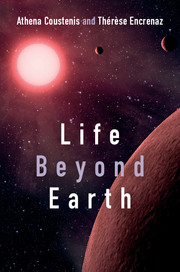Book contents
- Frontmatter
- Contents
- Preface
- 1 Introduction
- 2 What is life and where can it exist?
- 3 Terrestrial planets and their diverging evolutions
- 4 Searching for habitable sites in the outer Solar System
- 5 A revolution in astronomy: the exploration of extrasolar planets
- 6 Extraterrestrial habitable sites in the future
- Further reading
- Index
- Plate Section
4 - Searching for habitable sites in the outer Solar System
Published online by Cambridge University Press: 05 October 2013
- Frontmatter
- Contents
- Preface
- 1 Introduction
- 2 What is life and where can it exist?
- 3 Terrestrial planets and their diverging evolutions
- 4 Searching for habitable sites in the outer Solar System
- 5 A revolution in astronomy: the exploration of extrasolar planets
- 6 Extraterrestrial habitable sites in the future
- Further reading
- Index
- Plate Section
Summary
Looking for habitable conditions in the outer Solar System leads us to the natural satellites rather than the planets themselves. Although the theoretical conditions under which life might be sustained on natural satellites are similar to those of planets, there are key environmental differences which can make moons of particular interest in the search for extraterrestrial life. The gaseous giant planets cannot provide even the minimal conditions of a surface or interior with suitable pressures and temperatures to sustain life. But the moons around these planets offer a great range of possibilities for exploring habitability conditions and furthermore studying the question of the emergence and evolution of habitable worlds in our Solar System, in some cases more so than any other object closer to the Sun. Scientists generally consider the probability of life on natural satellites within the Solar System to be remote, though the possibility has not been ruled out.
Within the Solar System’s traditional habitable zone, the only candidate satellites are the Moon, Phobos and Deimos, and none of these has an atmosphere or water in liquid form. But, as discussed in Chapter 2, the habitable zone may be larger than originally conceived. The strong gravitational pull caused by the giant planets may produce enough energy to sufficiently heat the cores of orbiting icy moons. This could mean that some of the strongest candidates for harbouring extraterrestrial life are located outside the solar habitable zone, on satellites of Jupiter and Saturn. The outer Solar System satellites then provide a conceptual basis within which new theories for understanding habitability can be constructed. Measurements from the ground and also from the Voyager, Galileo and Cassini spacecraft have revealed the potential of these satellites in this context, and our understanding of habitability in the Solar System and beyond can be greatly enhanced by investigating several of these bodies together.
- Type
- Chapter
- Information
- Life beyond EarthThe Search for Habitable Worlds in the Universe, pp. 121 - 186Publisher: Cambridge University PressPrint publication year: 2013

